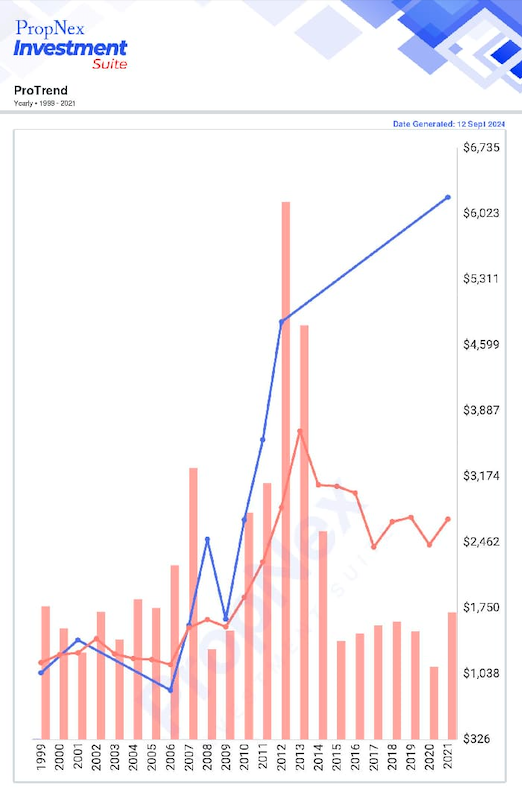PropNex Picks
|September 13,2024Shophouse Investment: Is It Worth The Nostalgia?
Share this article:
With an attractive tax system, a strategic location, good network and infrastructure, and strong trade opportunities, Singapore is well-regarded as an investment stronghold, providing both foreigners and locals plenty of opportunities to invest. In fact, when we talk about investment, some of the most common avenues are real estate, REITs, bonds, and stocks.
In Singapore, real estate can be divided into two categories, residential which includes HDB apartments, good class bungalows, private condos, and executive condos, and commercial which includes Grade A offices at the business district or parks, smaller offices and industrial properties. However, there is a unique property that kind of sits in the middle: shophouses. While there are many types of shophouses in Singapore (we will talk about them below), for the rest of the article, we will mainly be referring to conservation shophouses.
I have always been intrigued by and enamoured of shophouses. There is just something about them that exudes incredible class and charm. No matter how old you are, shophouses provide a glimpse into an era of boxy televisions and yellowing photographs. However, when it comes to investing in such a property, is it really worth the nostalgia? Let us find out!
Shophouses are unique cultural and architectural buildings commonly found in Southeast Asia countries, such as Singapore, Indonesia, Thailand, and Malaysia. In the past, and even for some in the present days, they combine commercial and residential spaces, typically with a storefront on the ground floor and living quarters above. In this article, we will mainly be talking about private shophouses.
They can be identified easily by their distinct architectural features:
- Structure and facade: Shophouses are generally narrow but extend deeply into the space. They are typically of two to three floors. Many shophouses feature intricate architectural details, such as carved wooden panels, shutters, and decorative tiles that often blend European, Chinese, and local designs.
- Five-foot ways: This is a distinct feature that shophouses have. It is usually a covered walkway that spreads across the front of the entire row of shophouses. It typically serves as a public pedestrian path and a sheltered space for business activities, fostering a unique streetscape and community interaction. Fun fact: Singapore Broadcasting Corporation (SBC), now known as Mediacorp, even filmed a drama series in 1987 with the name "Five Foot Way".
There are currently 6,500 shophouses that have been conserved by URA, of which many have been converted into offices, eateries, and boutique hotels. This number will stay the same unlike conventional properties which see new launches almost every year. As such they are a rare breed in the ever-changing landscape of Singapore.
There are several types of shophouses in Singapore, each with distinct functions and characteristics. Here is an overview of the different kinds of shophouses:
1. HDB shophouses
HDB shophouses are a common sight in the older public housing estates in Singapore, managed by the Housing & Development Board. They are designed to serve the everyday needs of residents and typically host businesses, such as eateries, clinics, and grocery stores. With a functional and modern design, they blend seamlessly into the surrounding HDB blocks, often with commercial spaces on the ground floor and residential units above.
2. Conservation shophouses
Conservation shophouses are historical gems scattered across districts, such as Kampong Glam, Little India, and Chinatown. They are privately owned properties that have been preserved for their architectural and cultural significance. Depending on the time period they are from, they feature intricate windows, colourful tiles, and ornate facades, offering a glimpse into Singapore's rich multicultural heritage. Today, they house a variety of businesses, from offices to trendy cafes and retail shops.
3. Commercial and mixed-use shophouses
Commercial and mixed-use shophouses are versatile properties found in key areas, such as the CBD, Orchard Road, and residential zones. These privately owned buildings serve multiple purposes, from residences,and offices to restaurants and retail stores. Whether historical or modern, they cater to a diverse range of audiences, combining residential and commercial functions within a single structure.
4. Residential shophouses
Residential shophouses are distinctive properties that primarily serve as homes, often located in a variety of districts, including some conservation areas known for their historical significance. Unlike mixed-use or commercial shophouses, they are designed purely for residential living, without the inclusion of retail or business spaces.
5. Industrial shophouses
Industrial shophouses, located in industrial zones, are designed for light industrial activities, such as storage, small-scale manufacturing, or workshops. These utilitarian and functional buildings may also include office or retail spaces, catering to the specific needs of businesses within the industrial sector.
1. Historical and architectural appeal
Shophouses are renowned for their distinctive architectural style, which combines elements of European, Chinese, and local designs. You get features, such as timber windows, front facades, airwells, and high ceilings that provide a space that is unmatched by many apartments, contributing to their timeless appeal.
When you invest in them, you also invest in Singapore's architectural heritage. This is a critical element that often does not come into many thought processes when they consider real estate investment. There are six styles of shophouses in Singapore.
Source: Straits Times
If you look at shophouses from an investment point of view, you are sitting on a potential treasure. According to URA, one of the biggest regulations when restoring a conservation shophouse is to maintain its traditional facade, such as special finishes, decorative features, five-foot way, signages, building colour and paint, as well as murals. This means that you can, technically, save significantly when designing and renovating the space for use, allowing you to refocus your capital for other purposes.
If you are investing in a conserved shophouse for commercial purposes, this is an added advantage, especially when we are in the age of social media. Modern commercialisation is built on the foundations of aesthetics. If your business offers a unique aesthetic, especially in terms of architecture, you can easily enjoy free marketability and higher asking price for your services and products.
2. Prime locations
Shophouses are typically located in prime urban areas, often in the heart of bustling commercial districts or heritage zones. This is because these areas were historically important trading hubs in the past and were close to key trading routes, ports, and commercial centres. These locations are highly sought after due to their proximity to amenities, vibrant atmosphere, and incredible accessibility. The central positioning of shophouses makes them attractive for both residential and commercial tenants, ensuring a steady demand and potentially high-rental yields.

Source: Investment Suite
The blue line represents the resale value of conservation shophouses while the red line represents the rest of the commercial sub-types (office, retail, and shops). From the extracted results, we can see that the resale value of shophouses have risen significantly over the years as compared to the rest of the commercial sub-types, which have dropped in resale value.
In my opinion, this could be due to the difference in foot traffic between shophouses and the rest of the commercial sites. Shophouses, due to their locality, are able to attract more street, foot, and eye traffic. Unlike typical commercial properties that may be enclosed within a typical office building or shopping mall, shophouses stand alone within their own plot of land, acting as a billboard for individuals walking or driving past them.
3. Flexible use
Shophouses in Singapore are typically zoned as both residential and commercial, with their specific use pre-determined by zoning and location. According to URA's Master Plan, orange zone is to be used for residential, which only locals can purchase, pink is for residential with first floor commercial, and blue is for mixed residential and commercial or full commercial purposes, which foreigners can purchase.
Foreigners interested in purchasing a shophouse for residential use need to get approval from the Land Dealings Approval Unit (LDAU). The approval process for such purchases is strict, and approval is typically granted only under exceptional circumstances, such as for certain strategic investments. This includes locally registered companies that are under foreign ownership. In such cases, the foreign shareholding percentage matters (more than 50%). The company may be treated similarly to foreign buyers under the Residential Property Act.
Source: URA Master Plan
One of the top benefits of shophouse investment is its scarcity. Similar to GCBs, there will not be any new conservation shophouses in the future. As such, it is considered a type of "collectors" property. In addition, commercial conservation shophouses are not subjected to ABSD, thus significantly reducing upfront costs, especially for investors who already own other properties.
You are able to choose which group of future buyers or tenants you want to appeal to. The uniqueness of shophouses is in its ability to provide you with a huge space, a home, and a workplace. The ground floor can be leased out for commercial purposes, such as retail shops, restaurants, cafes, or offices, while the upper floors can be rented out as residential units, serviced apartments, or co-living spaces. This mixed-use functionality maximises the property's revenue potential, providing a diversified source of income, and reducing the overall investment risk.
Beyond using it for commercial purposes, shophouses are gaining popularity among Singaporeans and expats. As mentioned earlier, shophouses in residential only zonings can only be purchased by locals. Foreign entities who are interested in procuring the property must seek approval from the LDAU.
Nevertheless, as younger individuals are becoming more affluent and being disinterested in conventional spaces, shophouses are able to meet the need for unique spaces. These spaces also provide access to social life and amenities in ways that conventional residential properties provide. The moment you step out of your house, you are greeted by the streets. Your neighbours, and potentially your best friends, are the cafes and bakeries you might visit often. It is this unique living that differs from conventional living that adds to the allure of shophouses.
While the benefits of shophouse investment sound compelling, there are also challenges to consider:
1. High initial costs
Due to their historical value and prime locations, the purchase price of shophouses can be significantly higher than most conventional properties. If you invest in commercial-residential and fully-residential shophouses, ABSD will be prorated based on the amount of residential area. Also, with the recent reduction of TDSR from 60% to 55%, the maximum amount of loan that one can take from the bank is lesser. Additionally, foreigners, PRs, and Singaporeans are all subjected to buyer's stamp duty of up to 3% for the commercial component and 4% for the residential component of the shophouse.
2. Maintenance and renovation
With power comes great responsibility, and in this case, owning a slice of Singapore's history comes with immense responsibilities. Historical buildings like shophouses require adequate care to ensure they stay for a long time, and any work that needs to be done must be kept aligned with the original facade. Hence, restorations and repairs must be carried out according to URA's specific conservation and restoration guidelines, which increases the overall renovation costs.
Fortunately, the government recognises the cultural value of shophouses and offers incentives for their preservation and restoration. These incentives can include subsidies, grants, or tax breaks aimed at maintaining the historical integrity of these buildings. Investors can benefit from these programmes, which can offset some of the costs associated with maintaining older properties.
3. Regulatory restrictions
URA's conservation guidelines for shophouses differ from district to district. However, one common guideline is that the front facade of the shophouse has to be retained and painted in traditional pastel hues and colours to retain the historic streetscape. For individuals looking to increase the gross floor area by constructing rear extensions, they are usually allowed only within secondary settlements, and that includes how high you can go.
For example, shophouses located in Joo Chiat are allowed to be extended up to five stories while shophouses located in Blair Plain cannot exceed three stories. The regulatory restrictions extend to the property's interior, too. Shophouse owners must seek written approval from the BCA and URA before commencing any renovations, alterations, and additions, whether internal or external. As such, it is vital that you work with an experienced interior design company to avoid any potential repercussions.
Shophouse investment offers a unique combination of flexibility, accessibility, and historical charm. While the maintenance requirements and initial costs can be high, the potential for market appreciation, combined with heritage conservation incentives, makes them an attractive investment opportunity.
For individuals who appreciate nostalgia and do not mind navigating through the challenges, investing in a shophouse can be a rewarding journey, both culturally and financially. As with any investment, careful planning and thorough research are vital to maximising your returns while preserving the unique heritage of these iconic buildings.
So, would you prefer living in a shophouse over a conventional apartment?
Views expressed in this article belong to the writer(s) and do not reflect PropNex's position. No part of this content may be reproduced, distributed, transmitted, displayed, published, or broadcast in any form or by any means without the prior written consent of PropNex.
For permission to use, reproduce, or distribute any content, please contact the Corporate Communications department. PropNex reserves the right to modify or update this disclaimer at any time without prior notice.






